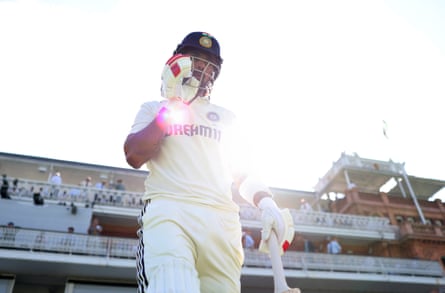The Guardian’s over-by-over coverage is built on reader interaction. We probably receive more than 1,000 emails during an average Test, hundreds of which are published. As an epic Lord’s Test unfolded, the same question kept dropping into our inboxes. “This is the second innings of the series that has left me baffled as to how KL Rahul averages only 35 in Tests,” began one such email from Ned Blackburn. “He seems to have the temperament, technique and discipline to be absolutely elite. What am I missing?”
Rahul’s Test average has become the unsolved mystery of the English summer. But after a day in the statistical dirt – and Ben Stokes thought he went to some dark places on Monday – we can offer some potential explanations. The simplest reason is that after a fine start to his career he became a superstar of Indian cricket, a status that is Kryptonite for an overthinker. “I just couldn’t get out of my own head,” he said in late 2023. “I couldn’t leave cricket or my professional life on the field. It was such a heaviness on me.”
All batters have a fallow period – but Rahul’s lasted the best part of six years. He averaged 26 from 28 Tests played between November 2017 and December 2023, including a desperate tour of England in 2018. Rahul made 113 runs in the first eight innings – including a technical change halfway through the Lord’s Test that solved one problem and created an even bigger one – before a dead-rubber century in the final Test.
Amid the extended struggle at Test level, there were two reminders of Rahul’s cathedral-high ceiling. In 2021 he made magnificent centuries in the toughest conditions at Lord’s and Centurion. Kevin Pietersen was often described as “a player of great innings rather than a great player”. Rahul played great innings in 2021, yet his overall record suggested he wasn’t even a very good player.
He has never been good at squeezing metaphorical lemons. The great batters usually wring every run out of a spell of good form; Rahul has always flattered to deceive. The current England tour is the first time he has made two centuries in one series and only the second time he’s managed three 50+ scores. For a player of his ability, those statistics are downright offensive.
Rahul had a different problem against Australia in 2016-17, when he stroked six fifties in seven innings, only to find weird and wonderful ways to get out without reaching three figures. He also has a poor appetite for cheap runs, a virtue in many ways but damaging in a game where statistics are gospel.
Just as Rahul has left plenty of runs out in the middle, so he has been denied access to plenty through injury or selection. The first example came in 2015, when he missed a one-off Test in Bangladesh through illness. The new opening pair, Murali Vijay and Shikhar Dhawan, banged 150 and 173 respectively in India’s only innings.

There were few dissenting voices when, after a two-year struggle, Rahul was dropped for the series against South Africa in 2019. In that series, the openers Rohit Sharma and Mayank Agarwal smashed five centuries, three of them huge, in only eight innings.
Such series are not the norm. The 2000s were an excellent time to open the batting in Tests, but it has since gone back to being the hardest gig in batting. Statistically, the 2020s are the toughest decade for openers since the 1900s. And while it doesn’t tell the whole story, one comparison suggests Rahul may not have done too badly. In the 61 Tests he has played, the other Indian openers – Yashasvi Jaiswal, Rohit, Dhawan and the rest – have a combined average of 37.55. That’s 0.6 better than Rahul when he joins them at the top.
Just as Peter Willey played 15 of his 26 Tests against the West Indies’ four horsemen, so Rahul’s excellence in tough conditions has probably counted against him. A startling 48% of his Tests have been in Sena countries (the abbreviation for South Africa, England, New Zealand and Australia, usually the toughest tours for subcontinental batters). Seven of his 10 Test hundreds have also been scored in those games.
after newsletter promotion
There should be more to come. At 33, Rahul looks like a man who has worked it out. Marriage and fatherhood have made him more relaxed about cricket. He is also less vulnerable to the psychological self-harm of social media and rolling opinion after making a conscious decision to change his habits. “Since then,” he said, “my life has been more peaceful.”
On the 2018 tour of England, Rahul was a walking wicket; seven years later he is more of a walking epiphany. He didn’t shy away from the conflict when the Lord’s Test threatened to turn nuclear, but he looked more detached – even amused – than the rest. He wears his seniority well. In a new, young India team, Rahul has gone from underachiever to Zen uncle.
Cricket has umpteen stories of supreme talents who finally worked it out at the back end of their careers, from Carl Hooper and Justin Langer to Graham Gooch and his mentor Ken Barrington. At the start of 1990, Gooch had an unbecoming average of 36.90. Five run-kissed years later, when he retired, it was 42.58.
Right now, in July 2025, there are lies, damned lies and KL Rahul’s Test average. But it’s not too late for the truth to emerge.
-
This is an extract from the Guardian’s weekly cricket email, The Spin. To subscribe, just visit this page and follow the instructions.

 3 months ago
48
3 months ago
48

















































